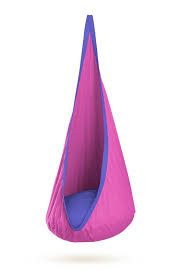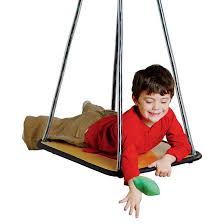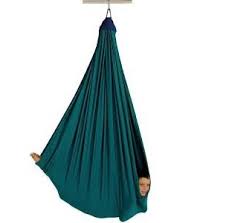What is Vestibular Input and What Therapy Helps?
- Alescia Ford-Lanza

- Sep 21, 2017
- 4 min read
Updated: Oct 19, 2018
originally written for and published on Harkla.co

What is Vestibular Input
The vestibular system includes parts of the inner ear and brain that are affected by movement. While it is a system that all of us have, unless you have vestibular system dysfunction as a child, teen, adult, or older adult, you likely have little knowledge about the intricacies of this system. While vestibular disorders can affect people across the lifespan, this article will talk specifically about vestibular processing as it relates to sensory integration and/or sensory processing disorder.
When occupational therapists talk about the sensory systems, most parents have not heard of the vestibular system at all, and yet it is a critical system because it affects development in other areas.
In it’s simplest form, vestibular input is the sensation of any change in position, direction, or movement of the head. The receptors are located in the inner ear and are activated by the fluid in the ear canals moving as you move. When you go upside down, for example, the fluid in your ear canals give your central nervous system information about your body’s position in space.
Vestibular input gives our bodies information about whether we are moving with or against gravity, fast or slow, moving or still, and what direction we’re headed. From infancy through adulthood, vestibular information contributes to the development of muscle tone, righting reactions, balance, postural security, eye movements, and overall alertness.
Vestibular Processing Dysfunction
If you’re a child who is processing vestibular information appropriately, you are able to move with control, balance and (relative) safety. You feel comfortable jumping, climbing, swinging, and taking calculated risks in your play because your vestibular sense is providing accurate information about where your body is in space.
If you’re a child who is demonstrating difficulty with processing vestibular information, you’re not as confident as the child mentioned above. You may be under- or over-responsive to movement which will impact your overall activity. If you’re under-responsive to vestibular input, you may be able to tolerate a lot of movement before it registers, therefore your body may be in constant motion. If you are over-responsive, or hypersensitive, to vestibular input, you may not be able to handle movement at all! Because of this difficulty, you may avoid activities that challenge your balance and coordination.
Both of these children can present as uncoordinated, and likely demonstrate ocular motor difficulties as well. The vestibular and visual systems work together when our central nervous systems are in accordance. Vestibular dysfunction can also manifest with difficulties tracking, focusing, and smoothly looking between two objects (saccades).
If a therapist has mentioned vestibular processing, some of the related behaviors you may observe are:
Low muscle tone
Fatigue/lethargy or persistent sitting
Resistance to movement
Clumsiness
Rocking, twirling, pacing, bolting (running away)
Head banging, shaking, or hitting
Vestibular Stimulation
When looking at designing a sensory diet for your child, you want to take a close look at the type of vestibular stimulation that your child is receiving. There is a difference between swinging on a regular playground swing versus fast spinning on the tire swing. One provides linear, rhythmic, predictable vestibular input and another provides rotary, sometimes arrhythmic, unpredictable vestibular input (especially if the tire swing has multiple kids jumping on/off and changing up the directions!). One type of swinging is calming and organizing (linear, rhythmic) while the other is alerting (rotary). An informed sensory diet will include specifically targeted vestibular activities to meet your child’s individual sensory profile.
Alerting qualities of vestibular input can include:
Angular or rotational movement
Unexpected, rapid movement
Bumpy, jerky movement
Changing direction
Bouncing
Head inversion (upside down)
Calming qualities of vestibular input can include:
Slow, rhythmic movement
Linear movement (one direction)
Slow movement provided with deep pressure
Predictable movement
The considerations for vestibular input also extend to how your child is moving - is he laying on his belly on the swing? Sitting upright? Hanging upside down? Laying on his side? When you change positions, you change which inner ear canals are activated by the movement. Again, this should be a consideration when selecting your child’s movement activities.
The following equipment or materials provide opportunities for vestibular activity that can be tailored to your child’s needs.
Swings - hammock, cuddle or pod, wooden platform, inner tube, rope swing, trapeze, frog swing, bolster swing… each swing can target different skills and be used in different ways, so it’s best to “consider a swing” with advice from your OT or get some ideas here.
Scooterboard - lots to do with a simple 4-wheeled scooter. Check out this list of ideas here.
Rocking chairs, gliders, slides, porch swings, rocking horses - take a look around the house to see what you already have that moves
Exercise ball or hippity hop - rolling, bouncing, upside down rocking…
Just you! What can you do to move your body in new ways? Try log rolling, toe touches, obstacle courses, and active play!
Once you know what your child needs to help activate their vestibular system, you’ll be able to see opportunity for purposeful activity in so much more. Have fun with your child and consider how much intensity of vestibular input is needed as you select your next play activity.
Sensory Integration Therapy - Vestibular Therapists
An occupational therapist who is well versed in sensory integration treatment will design a comprehensive sensory diet with targeted vestibular-based activities. These activities will be targeted to your individual child’s needs, so it’s best to seek out a skilled clinician who can diagnose and treat vestibular dysfunction. To find an SI-trained OT near you, check out STAR Institute’s OT resource page here.














